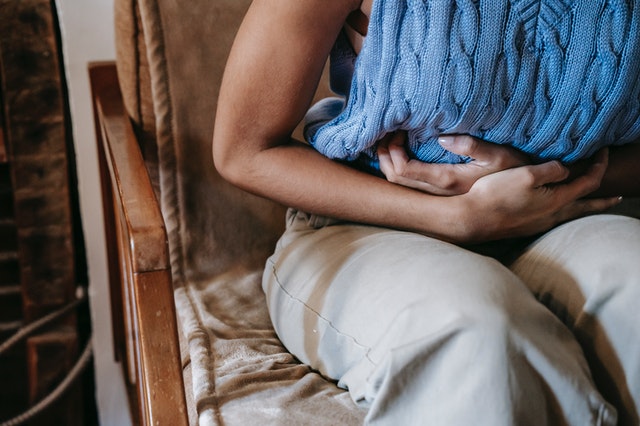Fibroids are the most common form of benign uterine tumors.1 In most cases, they are asymptomatic.1 But in 30% of cases, they are associated with a high health burden and seriously impact quality of life.2
For these women fibroids hurt. Depending on the fibroids weight, positioning and pressure on the pelvic organs, they can be associated with:
- heavy menstrual flow, prolonged bleeding, and consequent anemia and fatigue3
- dysmenorrhea and abdominal and pelvic pain3
- bloating3
- urinary symptoms3
- and even infertility3
In the most severe cases, the only solution is to intervene through surgical removal3 or non-surgical artery embolization, which consists of cutting-off their oxygen supply and results in fibroids shrinking.1
Instead, minor symptoms such as pain can be treated less invasively.
For instance, heat is a straightforward alternative: hot water bottles, heating pads or warm baths can facilitate muscle relaxation and relieve cramping.
Fibroid pain relief options
There are various medical treatments to address fibroid symptoms. For example, combined estrogen-progesterone contraceptives tend to improve menstrual flow and anemia in women with fibroids.1 They are available as pills, vaginal devices, or transdermal patches.1 Other medical management options include progestin-releasing uterine devices, oral progestins and ultrasounds.1
Many medical treatments are associated with side effects and complications; that’s why it’s important to discuss any potential risks and benefits with your doctor before making a decision.4
Of these medical treatments, a few can target fibroid-related pain relief:
- Hormonal therapy has been suggested as a valid conservative treatment option for pain associated with fibroids and other common fibroid-associated symptoms.3 Specifically, clinical trial data support the role of a selective progesterone receptor modulators, called ulipristal acetate (UPA), as a valid option to reduce fibroid volume, bleeding and pain.5
- Nonsteroidal anti-inflammatory drugs (NSAIDs), such as ibuprofen and naproxen may also be effective against pain.6
Is acupuncture effective for fibroid pain relief?
It has been suggested that not only hormonal but also complementary treatments can be valid options for fibroid pain relief to improve pelvic pain and period cramps compared to uterus preserving surgeries (UPS).7 There is a variety of complementary and alternative approaches associated with fibroids, but the improvement of symptoms has yet to be demonstrated.8
Acupuncture is already used in traditional medicine to treat other gynecological conditions such as dysmenorrhea. Preliminary data showed a potential for acupuncture for relief of uterine fibroid symptoms.9 Due to the lack of sufficient data to draw definitive conclusions more research is underway to evaluate the potential of acupuncture for fibroid pain relief.10,11
References
1. Giuliani, E., As-Sanie, S., & Marsh, E. E. (2020). Epidemiology and management of uterine fibroids. International journal of gynaecology and obstetrics: the official organ of the International Federation of Gynaecology and Obstetrics, 149(1), 3–9. https://doi.org/10.1002/ijgo.13102
2. Donnez, J., & Dolmans, M. M. (2016). Uterine fibroid management: from the present to the future. Human reproduction update, 22(6), 665–686. https://doi.org/10.1093/humupd/dmw023
3. Sohn, G. S., Cho, S., Kim, Y. M., Cho, C. H., Kim, M. R., Lee, S. R., & Working Group of Society of Uterine Leiomyoma (2018). Current medical treatment of uterine fibroids. Obstetrics & gynecology science, 61(2), 192–201. https://doi.org/10.5468/ogs.2018.61.2.192
4. Marret, H., Fritel, X., Ouldamer, L., Bendifallah, S., Brun, J. L., De Jesus, I., Derrien, J., Giraudet, G., Kahn, V., Koskas, M., Legendre, G., Lucot, J. P., Niro, J., Panel, P., Pelage, J. P., Fernandez, H., & CNGOF (French College of Gynecology and Obstetrics) (2012). Therapeutic management of uterine fibroid tumors: updated French guidelines. European journal of obstetrics, gynecology, and reproductive biology, 165(2), 156–164. https://doi.org/10.1016/j.ejogrb.2012.07.030
5. Donnez J, Donnez O, Matule D, Ahrendt HJ, Hudecek R, Zatik J, et al. Long-term medical management of uterine fibroids with ulipristal acetate. Fertil Steril. 2016;105:165–173.e4.
6. Mas, A., Tarazona, M., Dasí Carrasco, J., Estaca, G., Cristóbal, I., & Monleón, J. (2017). Updated approaches for management of uterine fibroids. International journal of women’s health, 9, 607–617. https://doi.org/10.2147/IJWH.S138982
7. Jacoby, V. L., Jacoby, A., Learman, L. A., Schembri, M., Gregorich, S. E., Jackson, R., & Kuppermann, M. (2014). Use of medical, surgical and complementary treatments among women with fibroids. European journal of obstetrics, gynecology, and reproductive biology, 182, 220–225. https://doi.org/10.1016/j.ejogrb.2014.09.004
8. Dalton-Brewer N. (2016). The Role of Complementary and Alternative Medicine for the Management of Fibroids and Associated Symptomatology. Current obstetrics and gynecology reports, 5, 110–118. https://doi.org/10.1007/s13669-016-0156-0
9. Cruz, J., Carrington, L., & Hong, H. (2019). A Feasibility Study on Treatment of Uterine Fibroids with Tung’s Acupuncture. Medical acupuncture, 31(6), 384–391. https://doi.org/10.1089/acu.2019.1385
10. Zheng, M. Q., Weng, C., Hu, W., Shen, C. Q., Tao, Y., & Pan, Z. W. (2020). Efficacy assessment of acupuncture in improving symptoms of uterine fibroids: A randomized controlled trial. Medicine, 99(18), e20016. https://doi.org/10.1097/MD.0000000000020016
11. Liu, T., Yu, J., Kuang, W., Wang, X., Ye, J., Qiu, X., Xi, W., Zeng, Y., Zou, H., & Liu, Y. (2019). Acupuncture for uterine fibroids: Protocol for a systematic review of randomized controlled trials. Medicine, 98(8), e14631. https://doi.org/10.1097/MD.0000000000014631
Photo by Sora Shimazaki from Pexels



